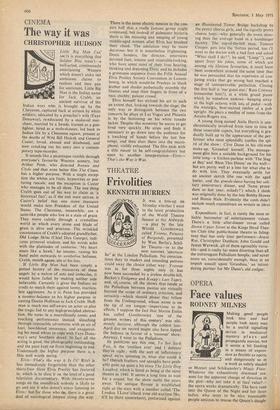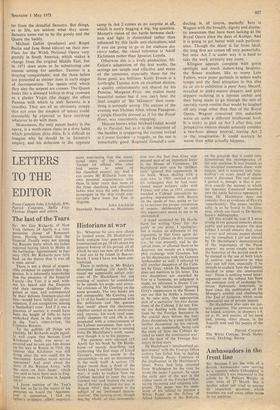OPERA
Face values
RODNEY MILNES
ter from the dreadful Sarastro. But things, as in life, are seldom what they seem: Sarastro turns out to be the goody and the Queen the baddy.
Michael Geliot (producer) and Roger Butlin and Jane Bond (decor) set their new Flute for the Welsh National Opera very prettily in South America, which makes a change from the original Middle East, but in 1971 does seem to be substituting one remote setting for another. Tamino is a straying conquistador, and the three ladies are presented as sinister nuns in early stages of decomposition. The spears with which they slay the serpent are crosses. The Queen looks like a diseased bishop in drag crowned as a plaster Virgin (the dagger she offers Pamina with which to stab Sarastro is a crucifix). They are all so obviously creepy that not even the simplest of tenors could reasonably be expected to have anything whatever to do with them.
Monostatos, the only patent baddy in the opera, is a moth-eaten cleric in a dirty habit which proclaims ditto ditto. It is difficult to imagine why he should be in Sarastro's employ, and his defection to the opposite
camp in Act 2 -comes as no surprise at all, which is surely begging a big, big question. Mozart's vision of the battle between dark- ness and light is diminished rather than enhanced by this facile anti-clericalism,-and if you are going to go in for trahison des clercs today, the visual reference is Adolf Eichmann rather than Ignatius Loyola.
Otherwise this is a lively production. Mr Geliot's adaptation of the text works, the settings are simple and effective and many of the costumes, especially those for the three genii, are brilliant. Keith Erwen is a forthright Tamino with an excellent diction, a quality unfortunately not shared by his Pamina, Margaret Price: she makes many beautiful noises but if you can't hear the final couplet of 'Bei Mannern' then some- thing is seriously wrong. The success of the evening was Thomas Allen, whose Papageno, a jungle Geordie dressed as if for the Royal Hunt, was consistently engaging.
Heaven knows what Michael Geliot would do to Parsifal, but as it is the treatment of the baddies is scuppering the current revival at Covent Garden—a tragedy, as the rest is remarkably good. Reginald Goodall's con- ducting is, of course, masterly: here is Wagner with the breadth, dignity and drama- tic awareness that have been lacking at the Royal Opera since the days of Kempe. And it is going to get better with each perform- ance. Though the decor is far from ideal, the long first act comes off very powerfully, but once Act 2 is under way it is hard to take the work seriously any more.
Klingsor appears complete with green spotlight and much demon-king laughter, the flower maidens, like so many Loie Fullers, wave paper garlands in sedate waltz tempo and the final attraction in this dim fin de siecle exhibition is poor Amy Shuard, revealed in pinky-mauve drapery and gold slippers reclining in a leprous orchid and then being made to go through the sort of operatic vamp routine that would be laughed off any stage other than that of the Royal Opera. Wagner conceived this seduction scene on quite a different intellectual level. It is tricky to pick up Act 3 after this, and prospective visitors should seriously consider a two-hour dinner interval, leaving Act 2 to the imagination. It could scarcely be worse than what actually happens.



































 Previous page
Previous page